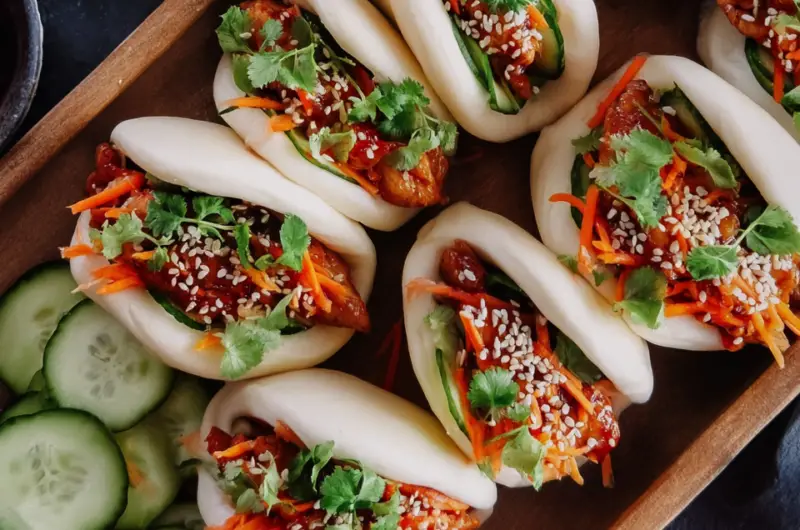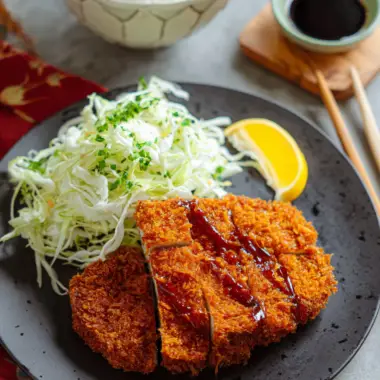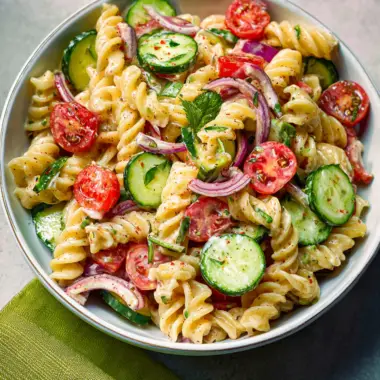The Chicken Bao Buns bring together the best of texture and taste in one handheld treat. Steamed to pillowy perfection, these soft buns are filled with savory hoisin-glazed chicken and fresh crisp veggies. The result is a beautiful contrast of flavors: sweet, spicy, tangy, and herbal. These buns make a stunning centerpiece for any dinner spread or a fun weekend kitchen project. Whether served as a starter, lunch, or main dish, Chicken Bao Buns are a satisfying nod to Asian street food with a homemade twist that’s easy to recreate. It’s a versatile and customizable dish that’s sure to please both adventurous eaters and comfort food lovers.
Full Recipe:
Ingredients:
-
2 cups all-purpose flour
-
1 tsp instant yeast
-
1 tbsp sugar
-
½ cup warm water
-
2 tbsp milk
-
1 tbsp vegetable oil
-
Pinch of salt
-
300g chicken thighs, boneless and skinless
-
2 tbsp hoisin sauce
-
1 tbsp soy sauce
-
1 tsp sesame oil
-
1 tsp grated ginger
-
2 garlic cloves, minced
-
1 small cucumber, julienned
-
Fresh cilantro leaves
-
Pickled red onions (optional)
Directions:
-
In a bowl, mix flour, yeast, sugar, salt. Add water, milk, and oil. Knead until dough is smooth (about 10 mins).
-
Cover and let rise for 1 hour or until doubled.
-
Meanwhile, marinate chicken in hoisin, soy sauce, sesame oil, garlic, and ginger for at least 30 mins.
-
Grill or pan-fry chicken until cooked and slightly caramelized. Slice thinly.
-
Divide dough into small balls, roll out into ovals, fold with parchment in the middle.
-
Steam buns for 10 minutes over medium heat.
-
Stuff each bun with sliced chicken, cucumber, pickled onions, and cilantro.
Prep Time: 25 minutes | Cooking Time: 25 minutes | Total Time: 50 minutes
Kcal: 310 kcal | Servings: 4 servings
The Ultimate Guide to Chicken Bao Buns: A Tale of Softness, Spice, and Street Food Perfection
Chicken Bao Buns have captured the imagination and taste buds of food lovers across the globe. These fluffy steamed buns, often associated with Chinese street food, have transcended regional boundaries to become a modern favorite in trendy restaurants, food markets, and home kitchens alike. Soft, pillowy exteriors encase savory, umami-rich fillings, and when made with marinated hoisin chicken, the experience becomes even more memorable.
Whether you’re a passionate home cook or a casual foodie, learning about Chicken Bao Buns means diving into the heart of Asian culinary tradition, innovation, and the perfect balance of texture and flavor. This dish is a celebration of contrasts light and dense, sweet and savory, spicy and fresh and mastering it is as rewarding as the first delicious bite.
The History and Origins of Bao Buns
Bao Buns, traditionally known as “Gua Bao” or “Baozi,” originated in China and date back centuries. They’re thought to have been first enjoyed during the Three Kingdoms period in the 3rd century AD. The term “bao” literally means “bun” or “to wrap,” and it typically refers to dough that’s steamed rather than baked. While there are many versions of bao across Asia ranging from fully enclosed buns filled with pork or vegetables to open-style buns used like a sandwich Gua Bao specifically refers to the folded bun variety filled with meats and toppings.
Historically, pork belly was the most common filling, seasoned with soy, sugar, and aromatic spices. Over time, variations began to emerge, especially as global culinary influences came into play. One of the most popular and accessible modern adaptations is Chicken Bao Buns, which replace pork with leaner, often quicker-cooking chicken, and often incorporate fresh vegetables and a tangy glaze for added complexity.
Why Chicken Bao Buns Are So Popular
The global rise of street food culture and a growing appreciation for Asian flavors have propelled dishes like Chicken Bao Buns into the spotlight. But popularity alone isn’t what makes them worth your attention. These buns are loved because they deliver an incredibly satisfying eating experience with contrasting textures and bold flavors.
-
Texture Sensation: The bun is steamed rather than baked or fried, giving it an unusually soft and slightly chewy texture. When paired with juicy, caramelized chicken, the contrast is delightful.
-
Flavor Balance: The combination of sweet hoisin sauce, savory soy, and spicy ginger or chili creates a complex flavor profile that appeals to all palates.
-
Customizable Components: Bao Buns are highly adaptable. You can adjust the spice levels, experiment with different pickled vegetables, or swap proteins to suit dietary needs.
Furthermore, they offer an element of novelty and interactivity. Much like tacos or sliders, they invite eaters to assemble or enjoy them hands-on, which makes them great for casual gatherings, parties, or even food truck fare.
Key Elements of the Dish
There are a few essential components that make Chicken Bao Buns shine:
1. The Bun
The defining feature is, of course, the soft bao bun. It’s made with a mixture of flour, yeast, water, sugar, milk, and oil. The dough is kneaded and allowed to rise, then shaped into oval pieces, folded, and steamed. This method ensures a light, fluffy texture that holds up to fillings without being overly heavy.
2. The Chicken Filling
Chicken thighs are typically used for their higher fat content and tenderness, making them ideal for absorbing marinades. Hoisin sauce, soy sauce, sesame oil, garlic, and ginger make up a flavorful, slightly sweet glaze. The chicken is usually grilled or pan-fried until caramelized and juicy.
3. The Fresh Toppings
Crisp cucumber, pickled onions, and fresh cilantro add brightness, acidity, and crunch. These toppings contrast beautifully with the rich, savory meat and soft bun. Optional additions like chili oil or crushed peanuts can enhance flavor and texture even more.
Cultural Significance and Modern Fusion
Chicken Bao Buns, while rooted in tradition, have undergone creative transformations in recent years. In many Western and fusion kitchens, chefs are taking the basic bao formula and elevating it with global ingredients think Korean kimchi bao, Indian butter chicken bao, or even vegan jackfruit bao.
The flexibility of the bun as a neutral yet soft carrier makes it an ideal platform for culinary experimentation. In some high-end restaurants, you might find bao buns with foie gras or smoked duck, while in street food stalls, you’ll see a variety of fillings inspired by different global cuisines.
This adaptability reflects how food culture today is both connected and creative. Diners seek authenticity but also crave novelty. Chicken Bao Buns strike the perfect chord between both worlds traditional yet open to interpretation.
Health and Nutrition Considerations
While bao buns might appear indulgent, they can be quite balanced when made thoughtfully. Chicken, especially when grilled or seared, is a lean source of protein. The bun, although made with white flour, is steamed not fried making it lighter than many other bread products.
Toppings like cucumber and pickled vegetables offer fiber, freshness, and a low-calorie way to bulk up the meal. And because the recipe can be modified, it’s easy to create a version that aligns with gluten-free, dairy-free, or low-sodium diets. Swapping in whole wheat flour, tofu, or plant-based proteins can further enhance the nutritional value.
Serving Suggestions and Pairings
Chicken Bao Buns are best enjoyed warm, just after steaming. Here are some ways to serve them:
-
As a Main Course: Serve with a light Asian slaw, sesame cucumber salad, or miso soup.
-
Party Platter: Mini bao buns make great finger food. Serve with dipping sauces like spicy mayo, sriracha, or ponzu.
-
Fusion Feast: Pair with Korean BBQ skewers, Thai peanut noodles, or Vietnamese spring rolls for an eclectic, pan-Asian meal.
Drink pairings might include jasmine tea, sparkling water with lime, or a crisp lager beer. For a more festive option, a sake cocktail or citrus-forward white wine works well too.
Tips for Success
Here are a few expert tips to ensure your Chicken Bao Buns turn out perfectly:
-
Steam with Care: Make sure your buns don’t touch each other in the steamer. Give them space to expand and become airy.
-
Rest the Dough: Don’t skip the rising time. Well-risen dough ensures fluffy texture.
-
Cook the Chicken Properly: Caramelization is key. Don’t overcrowd the pan, and allow the sauce to reduce slightly so it coats the chicken.
-
Assemble Just Before Serving: To avoid soggy buns, add the chicken and toppings right before serving for the best texture.
Conclusion:
Chicken Bao Buns are more than just a trendy bite they’re a culinary experience that bridges tradition with innovation. From the satisfying texture of the steamed buns to the bold, savory filling and fresh, vibrant toppings, every element of this dish works in harmony.
Whether you’re looking to recreate an Asian street food classic or explore new flavors in your kitchen, Chicken Bao Buns offer a playful, delicious, and rewarding project. They are equally perfect for casual dinners, party appetizers, or make-ahead lunches. Once you master the basic technique, the possibilities for customization are endless, allowing you to make this dish uniquely yours time and time again.








